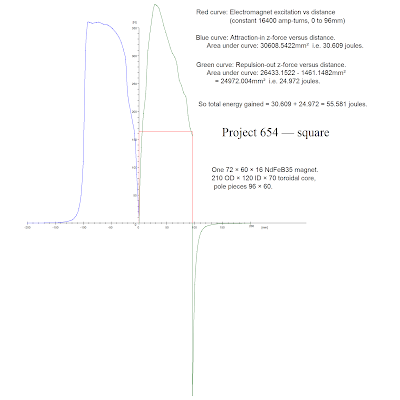Disc design modelling, without repelling stator magnets
 |
| Fig 3a Disc-design model |
Figure 3a shows one of my early models of a toroidal electromagnet plus permanent magnet, as would be used in a disc-design UAER motor. The pole pieces on the electromagnet core (grey) are each 96 × 60 × 6, with 0.5mm airgaps to the 96 × 60 × 16 NdFeB35 magnet (blue). So the magnet has the same surface dimensions and total thickness as the magnet pair used before in the drum design. The electromagnet coil (transparent red) has a 4927.5 mm² current injection plane (solid red) which in this model delivers the same constant square-wave excitation pulse of 16400 amp-turns while the magnet is being vertically displaced from 0 to 96mm, as before.
The magnet is first attracted in to the unenergized core, until there is zero vertical displacement, as shown. The electromagnet is then energized as noted above, to repel the magnet out from the core.
Once again, only forces in the vertical Z-direction are relevant to the analysis.
 |
| Fig 3b Modelling results, square-wave excitation |
Results
Figure 3b shows graphed results from this modelling.
The total energy gained is 55.581 joules, without any added stator magnets. This is a worthwhile improvement over the drum design, with or without stator magnets added to the latter. Admittedly the toroidal electromagnet core has a somewhat larger cross-section than the core of the drum design electromagnet, but the total volume of steel is much the same between the two options. They also have exactly the same total permanent magnet volumes, and excitations.
So, at least from the work done so far, it seems that the disc design of the UAER motor is preferable to the drum design.
Further modelling
 |
| Fig 4 Modelling results, half-sinewave excitation |
I have done quite a lot more modelling of versions of this design. Figure 4 shows graphed results from the same model as shown in Figure 3a except for a reduced-length permanent magnet, but with the excitation now a half-sinewave, with details as noted on the graph (red curve). This modelling was done for comparison with some real-world experiments, which I may discuss in future posts.
 |
| Fig 5 An experimental toroidal electromagnet I built in 2009 |
No comments:
Post a Comment
Note: only a member of this blog may post a comment.